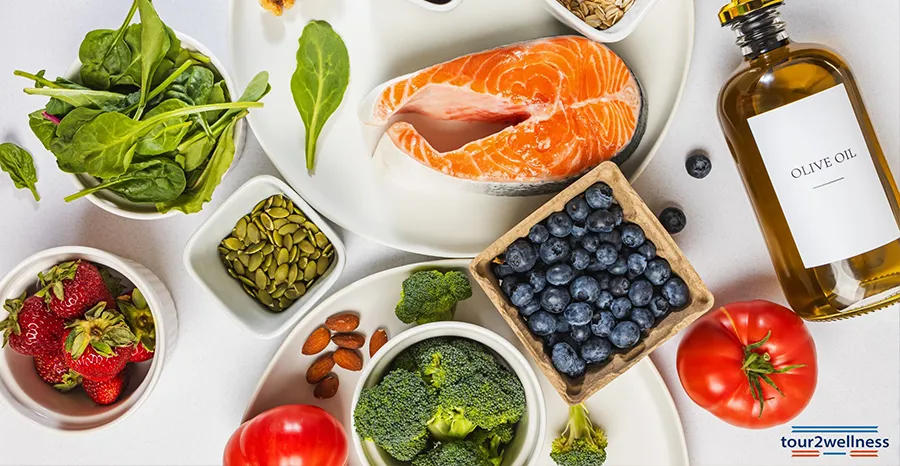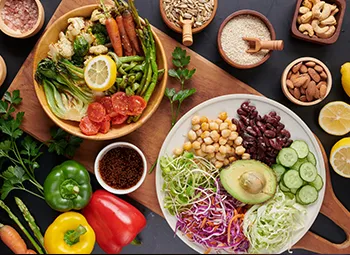
C Cardiovascular diseases (CVDs) remain the leading cause of mortality worldwide, claiming millions of lives each year. While genetics and lifestyle factors like exercise play crucial roles in heart health, the impact of diet is undeniable. Eating the right foods can significantly lower your risk of heart disease and improve overall health. In this blog, we’ll explore the components of a heart-healthy diet and offer practical tips to help you incorporate these elements into your daily routine.
Understanding Cardiovascular Diseases
Before diving into dietary recommendations, it’s essential to understand what cardiovascular
diseases are and why they pose such a significant health risk. CVDs encompass a range of
conditions affecting the heart and blood vessels, including:
⦁ Coronary artery disease (leading to heart attacks)
⦁ Hypertension (high blood pressure)
⦁ Heart failure
⦁ Stroke
⦁ Peripheral artery disease
These conditions often result from a combination of factors, including unhealthy diet, lack
of physical activity, smoking, and excessive alcohol consumption. However, by making
conscious dietary choices, you can take significant steps toward preventing these diseases.
Key Components of a Heart-Healthy Diet
1. Fruits and VegetablesFruits and vegetables are rich in essential vitamins, minerals, and antioxidants. They are
also high in dietary fiber, which helps reduce cholesterol levels and promotes healthy
digestion. Try to fill half of your plate with a variety of colorful fruits and vegetables
at every meal.
⦁ Leafy greens (spinach, kale, and Swiss chard) are particularly beneficial due to their
high content of vitamins, minerals, and nitrates that help regulate blood pressure.
⦁ Berries (strawberries, blueberries, and raspberries) are rich in antioxidants like
anthocyanins, which reduce inflammation and oxidative stress.
Whole grains, unlike refined grains, retain all parts of the grain kernel, providing more
nutrients and fiber. Consuming whole grains can help lower cholesterol and reduce the risk
of heart disease.
⦁ Oats, quinoa, brown rice, and whole wheat bread are excellent sources of whole grains.
⦁ Barley and bulgur are also heart-healthy choices, rich in fiber and essential nutrients.
Proteins are essential for building and repairing tissues, but not all protein sources are
heart-friendly. Opt for lean proteins that have minimal saturated fats.
⦁ Fish, especially fatty fish like salmon, mackerel, and sardines, are rich in omega-3 fatty
acids, which can reduce inflammation and lower the risk of heart disease.
⦁ Poultry, beans, lentils, and tofu are other excellent sources of lean protein.
⦁ Nuts and seeds provide healthy fats and protein but should be consumed in moderation due
to their high-calorie content.
Not all fats are created equal. Unsaturated fats can be beneficial for heart health, while
saturated and trans fats should be limited.
⦁ Monounsaturated fats (found in olive oil, avocados, and nuts) and polyunsaturated fats
(found in fatty fish, flaxseeds, and walnuts) can help reduce bad cholesterol levels.
⦁ Avoid trans fats commonly found in fried foods, baked goods, and processed snacks, as they
can increase the risk of heart disease.
High sodium intake is linked to increased blood pressure, a major risk factor for heart
disease. Reducing sodium in your diet can help maintain healthy blood pressure levels.
⦁ Flavor your food with herbs and spices rather than salt.
⦁ Avoid processed and packaged foods because they usually have a lot of sodium.

Practical Tips for a Heart-Healthy Diet
Incorporating heart-healthy foods into your diet doesn’t have to be complicated. Here are
some helpful tips to get you started:
Plan Your Meals
Planning your meals ahead of time can help ensure that you include a variety of
heart-healthy foods in your diet. Aim for balanced meals that include lean proteins, whole
grains, and plenty of fruits and vegetables.
Read Nutrition Labels
Understanding nutrition labels can help you make better food choices. Pay attention to the
amounts of saturated fat, trans fat, sodium, and added sugars in packaged foods.
Cook at Home
Cooking at home allows you to control the ingredients and the amount of salt and fat in your
meals. Experiment with heart-healthy recipes and cooking methods, such as baking, steaming,
and grilling.
Practice Portion Control
Even healthy foods can contribute to weight gain if eaten in large amounts. Practice portion
control by using smaller plates, eating slowly, and paying attention to your body’s hunger
and fullness cues.
Stay Hydrated
Staying well-hydrated by drinking plenty of water is essential for overall health, including
heart health. Water helps maintain blood volume and aids in the transportation of nutrients.
Avoid sugary drinks and opt for water, herbal teas, or other low-calorie beverages.
Here’s a simple meal plan to give you an idea of how to incorporate heart-healthy foods into
your diet:
Breakfast
Oatmeal with fresh berries and a sprinkle of chia seeds.
Whole grain toast with avocado and sliced tomatoes on the side.
Lunch
Quinoa salad with mixed greens, cherry tomatoes, cucumbers, and grilled chicken, drizzled
with olive oil and lemon juice. Fruit salad with a mix of your favorite fruits.
Dinner
Baked salmon served with steamed broccoli and brown rice on the side. Spinach and strawberry
salad with a light vinaigrette dressing.
Practice Portion Control
Even healthy foods can contribute to weight gain if eaten in large amounts. Practice portion
control by using smaller plates, eating slowly, and paying attention to your body’s hunger
and fullness cues.
Snacks
A handful of almonds or walnuts. Carrot sticks with hummus. A piece of fruit, such as an
apple or a banana.
While diet plays a critical role in heart health, it’s important to remember that it is just
one piece of the puzzle. Incorporating regular physical activity, managing stress, getting
adequate sleep, and avoiding smoking and excessive alcohol consumption are also crucial for
maintaining a healthy heart.
Regular Exercise
Make it a goal to reach 150 minutes of moderate exercise or 75 minutes of intense exercise
each week. Activities such as walking, cycling, swimming, and dancing can help improve
cardiovascular health.
Stress Management
Chronic stress can negatively impact heart health. Practice stress management techniques
such as mindfulness meditation, deep breathing exercises, and yoga to help reduce stress
levels.
Adequate Sleep
Prioritize quality sleep to reduce your risk of heart issues. Aim for 7-9 hours of sleep per
night to allow your body to rest and repair.
Avoid Smoking and Limit Alcohol
Smoking is one of the worst things you can do for your heart health. If you smoke, seek help
to quit. Additionally, limit alcohol intake to moderate levels – up to one drink per day for
women and up to two drinks per day for men.
Snacks
A handful of almonds or walnuts. Carrot sticks with hummus. A piece of fruit, such as an
apple or a banana.
A healthy heart diet is your key to preventing cardiovascular diseases and improving overall well-being. By focusing on nutrient-rich foods like fruits, vegetables, whole grains, lean proteins, and healthy fats, and by reducing sodium intake, you can take significant steps toward maintaining a healthy heart. Coupled with a healthy lifestyle, these dietary choices can help you lead a longer, healthier life. Remember, making small, sustainable changes to your diet and lifestyle can have a profound impact on your heart health. Start today, and take the first step toward a heart-healthy future.